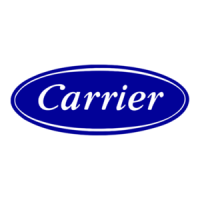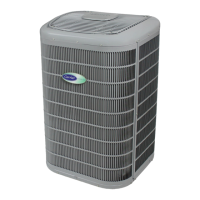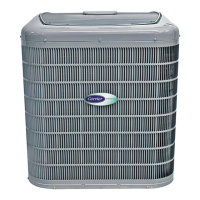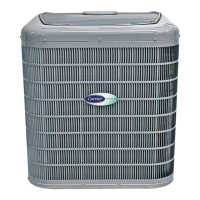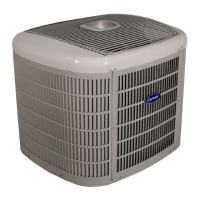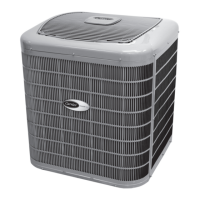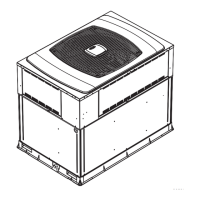24VNA6: Installation Instructions
Manufacturer reserves the right to change, at any time, specifications and designs without notice and without obligations.
8
Step 11 – Start-Up & Charging
Factory charge amount and desired subcooling are shown in the user
interface (UI). To properly check or adjust charge, conditions must be
favorable for subcooling charging in cooling mode. Favorable conditions
exist when the outdoor temperature is between 65°F (18°C) and
105°F(40.6°C) and the indoor temperature is between 65°F and 80°F. If
the temperatures are outside of these ranges, weigh-in charge only. If
confirmation is needed, return and check subcooling when the
temperatures are within the desired range.
Unit is factory charged for 15ft (4.57 m) of lineset and for smallest rated
indoor coil combinations. If any refrigerant charge adjustment is
required based on the indoor coil combination selected and the selected
line set length, the UI will calculate and display the target subcooling
and the amount of additional charge to be added. Therefore the UI is the
source of information for charging the system correctly. Refrigerant
charge adjustment amount for adding or removing 0.6 oz/ft (17.74 g/m)
of 3/8 liquid line above or below 15ft (4.57 m) respectively, and an
additional amount of refrigerant charge adjustment for a large ID coil if
required, is calculated and displayed by the UI. Perform a final charge
check only when in cooling and OD is between 65°F (18°C) and
105°F(40.6°C).
NOTE: UI indicates acceptable conditions for subcool charging mode.
Do not use subcooling charge method if outside 65°F (18°C) and
105°F(40.6°C) outdoor temperature. Subcool charging mode will not be
available if conditions are not acceptable.
Follow these steps to properly start up the system:
1. After system is evacuated, close the disconnects to energize indoor
unit, outdoor unit, and User Interface (UI). Do not attempt to
operate the system in heating or cooling mode at this time. Mode:
OFF. Vapor and liquid line service valves should be fully closed.
2. If the outdoor ambient temperature is between 65°F and 105°F and
the indoor temperature is between 65°F and 80°F then the system
will be charged using the subcooling method. At this time fully
open the liquid and vapor service valves if the subcooling method is
to be used.
3. If the user interface is new then the UI will proceed through a series
of setup screens. Proceed through these setup screens until the
equipment summary screen is reached (see Fig. 10). Verify that the
correct equipment is shown on this screen. If the installed indoor
unit is a furnace coil verify that this has been selected. The UI will
then proceed through an airflow verification test and then return to
the main screen.
4. Navigate to the service area by pressing MENU from main screen
(see Fig. 11). Scroll down to service icon and hold until icon turns
green. Once in the "Installation and Service" menu, select
"Refrigerant Charging" (see Fig. 12).
A200028CA
Fig. 10 – Equipment Summary Screen
A200029CA
Fig. 11 – Service Icon
A20030
Fig. 12 – Select Refrigerant Charging
CAUTION
!
UNIT OPERATION AND SAFETY HAZARD
Failure to follow this caution may result in minor personal injury,
equipment damage or improper operation.
Observe the following:
1. Do not overcharge system with refrigerant.
2. Do not operate unit in a vacuum or at negative pressure.
3. Do not disable low pressure transducer or system safety devices
such as discharge thermistor or the high pressure switch.
4. Dome temperatures may be hot.
5. Discharge thermistor is engaged tight on the discharge tube.
CAUTION
!
PERSONAL INJURY HAZARD
Failure to follow this caution may result in personal injury.
Wear safety glasses, protective clothing, and gloves when handling
refrigerant.
CAUTION
!
ENVIRONMENTAL HAZARD
Failure to follow this caution may result in environmental damage.
Federal regulations require that you do not vent
refrigerant to the atmosphere. Recover during system
repair or final unit disposal.
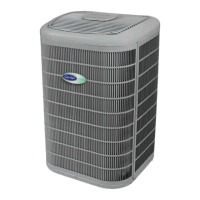
